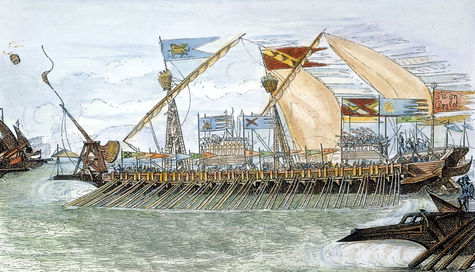Difference between revisions of "Korcula Dialect"
(→Notes and References: Removed) Tags: Mobile web edit Mobile edit |
(layout) |
||
| Line 9: | Line 9: | ||
| − | + | ||
| − | + | ||
| + | |||
| + | |||
| + | |||
| + | |||
== Examples == | == Examples == | ||
| + | |||
| + | |||
| + | |||
| + | |||
| + | |||
| + | |||
| + | |||
| + | |||
| + | |||
| + | |||
| + | |||
| + | |||
| + | |||
| + | |||
| + | |||
| + | |||
| + | |||
| + | |||
| + | |||
| + | |||
| + | |||
| + | |||
| + | |||
| + | |||
| + | |||
| + | |||
| + | |||
| + | |||
| + | |||
| + | |||
| + | |||
| + | |||
| + | |||
| + | |||
| + | |||
| + | |||
| + | |||
| + | |||
Examples of '''Corzulot''' words compared with Vegliot, English and Croatian: | Examples of '''Corzulot''' words compared with Vegliot, English and Croatian: | ||
| − | Corzulot - '''Dalmatian Vegliot''' - English - Croatian<ref>[//books.google.com.au/books?id=_lNjHgr3QioC&pg=PA132&lpg=PA132&dq=Croatian+Identity&source=bl&ots=fD7ElNqJfQ&sig=b_VK71LL4FYXG7LBjfPVUCSVC-E&hl=en&sa=X&ei=eSClVOSxLuLWmAW484HYDQ&ved=0CEAQ6AEwBzgK#v=onepage&q=Croatian%20Identity&f=false Language and Identity in the Balkans:] Serbo-Croatian and Its Disintegration ... By Robert D. Greenberg</ref> | + | Corzulot - '''Dalmatian Vegliot''' - English - Croatian <ref>[//books.google.com.au/books?id=_lNjHgr3QioC&pg=PA132&lpg=PA132&dq=Croatian+Identity&source=bl&ots=fD7ElNqJfQ&sig=b_VK71LL4FYXG7LBjfPVUCSVC-E&hl=en&sa=X&ei=eSClVOSxLuLWmAW484HYDQ&ved=0CEAQ6AEwBzgK#v=onepage&q=Croatian%20Identity&f=false Language and Identity in the Balkans:] Serbo-Croatian and Its Disintegration ... By Robert D. Greenberg</ref> |
* buža - bus - hole - rupa | * buža - bus - hole - rupa | ||
* čimitir - chimitier - graveyard - groblje | * čimitir - chimitier - graveyard - groblje | ||
| Line 27: | Line 69: | ||
'''Encyclopedia Britannica''' on Vegliot: {{quote| | '''Encyclopedia Britannica''' on Vegliot: {{quote| | ||
''Romance language formerly spoken along the Dalmatian coast from the island of Veglia (modern Krk) to Ragusa (modern Dubrovnik). Ragusan Dalmatian probably disappeared in the 17th century. The Vegliot Dalmatian dialect became extinct in the 19th century''.}} | ''Romance language formerly spoken along the Dalmatian coast from the island of Veglia (modern Krk) to Ragusa (modern Dubrovnik). Ragusan Dalmatian probably disappeared in the 17th century. The Vegliot Dalmatian dialect became extinct in the 19th century''.}} | ||
| + | [[File:Korcula Postcard 1902.jpg|thumb|right|275px|A '''Korcula''' postcard from 1902 in Italian. The last Italian government school was abolished in Korcula on the 13th of September 1876.]] | ||
==Additional examples of words from the Korcula dialect of Croatia == | ==Additional examples of words from the Korcula dialect of Croatia == | ||
| Line 209: | Line 252: | ||
* From the late 19th century onwards the old [[Dalmatian Italians#The Cultural and Historical Venetian Presence in Dalmatia |Dalmatian]] culture has been all but disappearing from the region. | * From the late 19th century onwards the old [[Dalmatian Italians#The Cultural and Historical Venetian Presence in Dalmatia |Dalmatian]] culture has been all but disappearing from the region. | ||
| − | [[File:242424 1862049509067 689609 o.jpg|thumb| | + | [[File:242424 1862049509067 689609 o.jpg|thumb|left|500px|A ''Vela Luka-Vallegrande'' postcard from 1903, written in Croatian and [[Italy|Italian]]. Photo taken by Ernesto Furlani.]] |
| + | [[File:Korcula Town.jpg|thumb|left|315px|Korcula Town photo by [[Peter Zuvela]]]] | ||
| + | |||
| + | |||
| + | |||
| + | |||
| + | |||
| + | |||
| + | |||
| + | |||
| + | |||
| + | |||
| + | |||
| + | |||
| + | |||
| + | |||
| + | |||
| + | |||
| + | |||
| + | |||
| + | |||
| + | |||
| + | |||
| + | |||
| + | |||
| + | |||
| + | |||
| + | |||
| + | |||
| + | |||
| + | |||
| + | |||
| + | |||
| + | |||
| + | |||
| + | |||
| + | |||
| + | |||
| + | |||
| + | |||
| + | |||
| + | |||
| + | |||
| + | |||
| + | |||
| + | |||
| + | |||
| + | |||
| + | |||
| + | |||
| + | |||
| + | |||
| + | |||
== Additional History == | == Additional History == | ||
| Line 246: | Line 341: | ||
* [http://en.wikipedia.org/wiki/Battle_of_Curzola Wikipedia: Battle of Curzola] | * [http://en.wikipedia.org/wiki/Battle_of_Curzola Wikipedia: Battle of Curzola] | ||
* [http://www.vlada.hr/en Government of the Republic Croatia - Official Web Portal] | * [http://www.vlada.hr/en Government of the Republic Croatia - Official Web Portal] | ||
| + | |||
| + | |||
| + | |||
| Line 251: | Line 349: | ||
[[File:85px-Coat of arms of Croatia.svg.png||thumb|left|250px|Coat of arms of Croatia (Hrvatska)]] | [[File:85px-Coat of arms of Croatia.svg.png||thumb|left|250px|Coat of arms of Croatia (Hrvatska)]] | ||
| + | |||
| + | |||
| + | |||
| + | |||
| + | |||
| + | |||
| + | |||
| + | |||
| + | |||
| + | |||
| + | |||
| + | |||
| + | |||
| + | |||
| + | |||
| + | |||
| + | |||
| + | |||
==Notes and References== | ==Notes and References== | ||
| Line 256: | Line 372: | ||
<references /> | <references /> | ||
</div> | </div> | ||
| + | * Venetian-English English-Venetian: When in Venice Do as the Venetians by Lodovico Pizzati | ||
* Encyclopedia Britannica: "Korčula, Italian Curzola, Greek Corcyra Melaina, island in the Adriatic Sea, on the Dalmatian coast, in Croatia. With an area of 107 square miles (276 square km), it has a hilly interior rising to 1,863 feet (568 m). The Greeks colonized it in the 4th century bc. Korčula was subsequently occupied by the Romans, Goths, Slavs, Byzantines, and Genoese; the kings of Hungary and Croatia" | * Encyclopedia Britannica: "Korčula, Italian Curzola, Greek Corcyra Melaina, island in the Adriatic Sea, on the Dalmatian coast, in Croatia. With an area of 107 square miles (276 square km), it has a hilly interior rising to 1,863 feet (568 m). The Greeks colonized it in the 4th century bc. Korčula was subsequently occupied by the Romans, Goths, Slavs, Byzantines, and Genoese; the kings of Hungary and Croatia" | ||
*Dalmatia and Montenegro: With a Journey to Mostar in Herzegovina by Sir John Gardner Wilkinson.Sir John Gardner Wilkinson (October 5, 1797 – October 29, 1875) was an English traveller, writer and pioneer Egyptologist of the 19th century. He is often referred to as "the Father of British Egyptology. | *Dalmatia and Montenegro: With a Journey to Mostar in Herzegovina by Sir John Gardner Wilkinson.Sir John Gardner Wilkinson (October 5, 1797 – October 29, 1875) was an English traveller, writer and pioneer Egyptologist of the 19th century. He is often referred to as "the Father of British Egyptology. | ||
* Becoming Slav, Becoming Croat: Identity Transformations in Post-Roman and Early Medieval Dalmatia by Danijel Dzino. | * Becoming Slav, Becoming Croat: Identity Transformations in Post-Roman and Early Medieval Dalmatia by Danijel Dzino. | ||
| − | |||
* Venice and the Slavs: The Discovery of Dalmatia in the Age of Enlightenment by Larry Wolff. | * Venice and the Slavs: The Discovery of Dalmatia in the Age of Enlightenment by Larry Wolff. | ||
* '''Note''': Recent DNA studies have stated that more than three quarters of today's Croatian men are the descendants of Europeans who inhabited Europe 13 000-20 000 years ago. The first primary source (factual-that its authenticity isn't disputed) to mention the Croatian-Hrvat identity in the Balkans was Duke Branimir (Latin: "Branimiro comite dux cruatorum cogitavit" c. 880 AD). Branimir was a Slav from Dalmatia. | * '''Note''': Recent DNA studies have stated that more than three quarters of today's Croatian men are the descendants of Europeans who inhabited Europe 13 000-20 000 years ago. The first primary source (factual-that its authenticity isn't disputed) to mention the Croatian-Hrvat identity in the Balkans was Duke Branimir (Latin: "Branimiro comite dux cruatorum cogitavit" c. 880 AD). Branimir was a Slav from Dalmatia. | ||
| Line 277: | Line 393: | ||
* Beginnings of Formal Education - Vela Luka: (beginnings of literacy and Lower Primary School 1857 – 1870) | * Beginnings of Formal Education - Vela Luka: (beginnings of literacy and Lower Primary School 1857 – 1870) | ||
*'''Note''': The traditional Klapa was composed of up to a dozen male singers (in recent times there are female Klape groups). Klapa singing dates back centuries. The arrival of the Slavic-Croatians to Dalmatia and their subsequent settlement in the area, began the process of the cultural mixing of Slavic culture with that of the traditions of the Roman-Latin population of Dalmatia. This process was most evident in the coastal and island regions of Dalmatia. In the 19th century a standard form of Klapa singing emerged. Church music heavily influences the arrangements of this music giving it the musical form that exists today. | *'''Note''': The traditional Klapa was composed of up to a dozen male singers (in recent times there are female Klape groups). Klapa singing dates back centuries. The arrival of the Slavic-Croatians to Dalmatia and their subsequent settlement in the area, began the process of the cultural mixing of Slavic culture with that of the traditions of the Roman-Latin population of Dalmatia. This process was most evident in the coastal and island regions of Dalmatia. In the 19th century a standard form of Klapa singing emerged. Church music heavily influences the arrangements of this music giving it the musical form that exists today. | ||
| − | + | ||
Revision as of 06:47, 11 October 2022
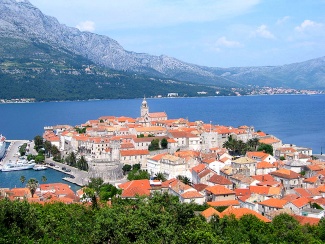
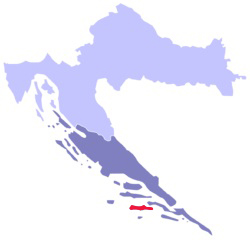
Korcula dialect (or Korčulanski) is a Croatian dialect from the island of Korčula. The island of Korčula lies just off the Dalmatian coast in Croatia. The language base of the Korčula dialect is Chakavian Croatian (Old Croatian plus it is also intermixed with Shtokavian). The dialect has remnants of the extinct Latin Romance language, Dalmatian. The Dalmatian remnants within the dialect have been sometimes referred to as Corzulot. Additionally it has strong influences of Venetian-Italian.
The local dialect in the past was referred (and is still sometimes today) to as Naski or more correctly Naški. The š is pronounced sh. Sir John Gardner Wilkinson, a 19 century English historian, referred to the Dalmatian Slavic dialect as Illirskee. He also wrote “Italian is spoken in all the seaports of Dalmatia “.
Examples
Examples of Corzulot words compared with Vegliot, English and Croatian:
Corzulot - Dalmatian Vegliot - English - Croatian [1]
- buža - bus - hole - rupa
- čimitir - chimitier - graveyard - groblje
- dent - diant - teeth - zubi
- faculet - fazuol - handkerchief - rubac
- fatiga - fatica - work - radi
- fermaj - fermai - stop - stoj
- jeloz - golaus - jealous - ljubomoran
- kantat - cantar - to sing - pjevati (Latin: canto)
Encyclopedia Britannica on Vegliot:
Additional examples of words from the Korcula dialect of Croatia
(Korčula dialect - English - Croatian)
Template:Col-break- adio - goodbye - doviđenja (addio: meaning in Italian goodbye)
- afitat - rent (Venetian:afìt)
- aimemeni - poor me or oh dear
- alavia - done properly or it's Ok! - u redu
- apoteka - pharmacy (Venetian: apoteca)
- arbol - ship's mast (In Venetian it means tree)
- aria - air - zdrak (Venetian: aria)
- arma - armed (Venetian: arma)
- avižat - to arrive - došao
- baleta - bullet - metak (Venetian: bal)
- banda - side - strana (In Venetian it means side & flank)
- balun - football (Venetian: balón)
- banak - bench (Venetian: banca)
- baraka - shed or shack (Venetian: baràca)
- barba - uncle - stric (Venetian: barba)
- barilo - barrel (Venetian: barìla)
- barka - type of local boat (Venetian: bàrca)
- bat - a type of hammer (Venetian: batu meaning to strike)
- bevanda - wine with water - vino sa vodom (Venetian: bevànda "watery wine")
- beštija - animal - životinja (Latin: bestia also beast)
- beštimat - swear (Venetian: bestiemàr)
- bičve - socks - čarape
- bićerin - small glass (Venetian: bicér "glass")
- Brigela - local nickname (Venetian: brighela joker)
- bobon - lolly
- boca - bottle - flaša (Venetian: boca)
- bonaca - the sea is dead calm (Venetian: bonàça)
- botilja - bottle (Romance Dalmatian: botaila)
- botun - button (Romance Dalmatian: botaun)
- bravo - well done
- buka - noisy (Romance Dalmatian: mouth)
- bukva - herring
- bura - local wind
- butiga - shop
- buža - hole - rupa (Venetian: bus or buxa)
- cilo - wine without water - vino bez vode
- cukar - sugar - šečer (Venetian: sucaro)
- čakule - gossip
- čagalj - jackal
- čorav - blind (Venetian: ciòro "blind person")
- damižana - a netted bottle
- daž - rain - kiša
- Dreto - straight (Romance Dalmatian: drat)
- Defora in old Venetian means "from the outside".
- Di greš?- Where are you going?
- faca - face - lice (Venetian: faca)
- fabrika - factory - tvornica (Latin: fabrica- manufacture or to craft, trade, art, trick, device)
- fabrikat - to trick
- falso - fake (Venetian: falso "liar")
- feral - a gas or petroleum lamp for attracting fish (night fishing). Also in Venetian feral means "lamp".
- fermai - stop - stani
- feta - slice (Venetian: feta)
- figura - figure (Venetian: figura)
- fjaka - When one feels sleepy on a lazy summer day afternoon.
- forma - shape (Venetian: forma)
- fraja - to go out and have a good time (Venetian: fraja-happy company or happy bunch)
- frigati - to fry (Romance Dalmatian: fregur)
- forca - power (apply with strength)
- fortuna - strong wind
- fratar - priest (Latin: frater meaning brother)
- fuga - gap (Latin: flight, escape)
- fumar - chimney (Venetian: fuma meaning smoke)
- fumati - smoking - pušiti
- furešti - foreigner - stranac
- gira - a fish from Croatia.
- griža - a form of very hard stone
- gundula - type of boat
- gusti - enjoyment (Venetian: gusto-pleasurable)
- gusto - thick
- gustrina - underground rainwater reservoir
- guzica - bottom
- hoča - lets go
- idra or jidra - sails
- ito- and - i
- izilo - eaten
- kadena - chain (Romance Dalmatian:kataina)
- kajić - type of local boat
- Kalafat - means masters (shipyard workers) who filled the fissures between boards on a wooden boat.
- kamara - bedroom - soba (Latin: camera-vault, vaulted room)
- kantat - to sing - pjevati (Latin: canto)
- kapula - onion - luk (Romance Dalmatian: kapula)
- karoca - small carriage (Venetian: carosa)
- katrida - chair - stolica (Romance Dalmatian: katraida)
- katun - corner (Latin: cantus)
- klapa - an a cappella form of music (Venetian:clapa "singing crowd")
- koltrine - curtains
- kontra - against - protiv (Latin: contra)
- korač - hammer
- kormilo - rudder
- kurijozan - curiosity
- kužin - cousin - rođak (Venetian: cuxìn)
- lacun - bed sheets
- lapis - pencil - olovka (Venetian: apis)
- lavadin - washbasin (Venetian: lavandin)
- lešada - a type of fish soup (boiled)/ Lesada in Venetian means boil.
- leut - type of local boat
- levant - local wind
- libro - book - knjiga
- licenca - licence - dozvola (Venetian: icenca)
- lipo - nice or beautiful - ljepo
- maistral - local wind
- makina - machine or engine
- Malandrin - Local nickname. In Venetian it means: dishonest or crook
- mat or mati - mother - majka
- Maragun - wood worker (Venetian: Marangòn)
- mapa - map (Venetian: mapa)
- meća - to throw
- mezo - in between (Venetian: mèzo "half")
- mlinko - milk
- motika - local agricultural tool
- mudante - underwear (Venetian: mudande)
- noštromo - boatswain
- parića - to prepare
- pamidora - tomato (Italian pamidore)
- pandur - policemen - policija (Venetian: panduro)
- papit - this word is used when feeding a child - jedi djete (Venetian: papa-means baby food)
- perun - fork (Venetian: pirón from Greek: pirouni)
- piat - plate
- pikolo - small, little (Venetian: picolo)
- Pelišac - Pelješac (other names used: Stonski Rat, Puncta Stagni, Ponta di Stagno and Sabioncello)
- pirula - pill - tableta (Venetian: pirola)
- pistun - piston (Venetian: piston)
- pitura - paint (Venetian: pitura-painting)
- poć na ribe - going fishing - ići na ribanje
- Pola - Pula (a city in today's modern Croatia)
- porat or porto - port, harbour - luka
- postoli - shoes - cipele
- postelja - bed
- potato - potato - krumpir
- punistra - window (Latin: fenestra)
- rič - word
- ritko - not often
- setemana - week - tijedan (Venetian: setemana)
- spim - I'm sleeping
- skula - school - škola
- soldi - money - novac (Latin: solidus)
- soto - underneath - ispod (Venetian: sot or soto)
- svit - people - narod
- šestan - attractive or good looking (Venetian:sesto-grace, well mannered)
- šija - reverse - natrag
- šiloko - local wind (Venetian: siròco)
- škoj - island - otok
- škver - shipyard - brodgradilište
- špirit - spirit
- šporko - dirty (Venetian: spórco)
- štrada - street - ulica
- šufit - attic or loft (Venetian: sofìta)
- šugaman - beach towel
- tata - father - otac
- torta - a type of cake (Venetian: torta)
- tavajol - tablecloth (Venetian: toaja)
- temple or timpre - temple (anatomical)
- terpeza - table - stol
- ura - hour - jedan sat
- vapor - ferry - trajekt (Venetian: Bapor meaning steamship)
- vara vamo - move on
- vedro - clear sky
- vijaž (or vijaz) - meaning a sailors tour
- vrime (or brime) - weather - vrijeme
- Vi ga niste vidili - You did not see him.
- zeje - local dish
- zrcalo - mirror - ogledalo
Each town and village on the island have their own unique version of the dialect. The Korčula dialect is found in the local folk music. The local Klape groups (an a cappella form of music) sing using the Korčula dialect. The well know Croatian singer, Oliver Dragojevic, has used the dialect in his music.
One of Korčula's older names was Curzola. The island was from 1420 to 1797 part of the Republic of Venice. The Old-Slavic term was Krkar. According to Antun Rosanovic (Defence of Korcula in 1571) the Greeks named it Kórkyra Melaena meaning Black Corfu after their homeland and the dense woods on the island.
Note: The last Italian language government school was abolished in Korčula (Curzola) on the 13th of September 1876.
- Information below taken from Beginnings of Formal Education - Vela Luka:
"Italian language was not only the official language in all public Dalmatian establishments, but also was the spoken language in a significant number of white-collar, civil service and merchant families in the cities and major markets within towns. "
- From the late 19th century onwards the old Dalmatian culture has been all but disappearing from the region.
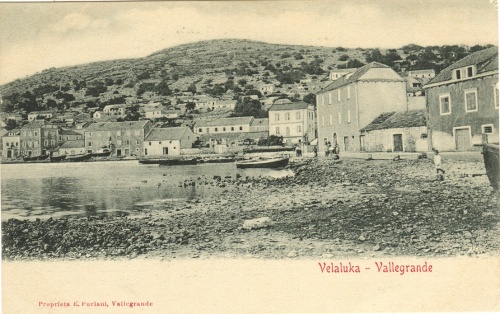
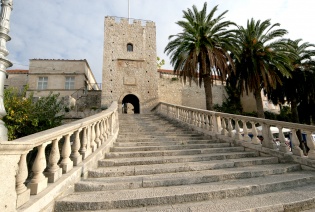
Additional History
Arneri Lords of Korcula
Historic quote taken from Researches on the Danube and the Adriatic written by Andrew Archibald Paton in 1861. Chapter 4 - The Dalmatian Archipelago on page 164.
- Signor Arneri from the town of Korčula stated to Andrew Archibald Paton:
Note: Andrew Archibald Paton (1811-1874) was a British diplomat and writer from the 19 century he visited Korčula in the early 1860s. He spoke Italian very fluently.
Canon Pietro Casola's Pilgrimage to Jerusalem
- Below is Pietro Casola writing about Korčula (Curzola) in 1494:
" On Friday, the 13th of June, we left the canal of Lesina [Hvar-Editors note] after sunrise and made sail with a very slight wind ; but as the day advanced the wind improved and we came opposite the citadel of Curzola (Note 58), which is beautiful to look at from the outside. The captain did not wish to stop there for fear of losing the favourable wind, and thus we passed by, and could only admire the place from the outside; it is said to be sixty miles from Lesina. The captain related that a few years ago King Ferdinand, the former King of Naples, sent his fleet there to pry and steal it from the Venetians, but he failed completely because the people of Curzola were valiant, and defended themselves from that attack without additional help from the Signoria of Venice, to whom they are subject. (p171)
Curzola: Reached Curzola, (1.) a citadel in Dalmatia, and as bright and clean as a beautiful jewel. It has no drawbridges, but it has strong walls, and it will be stronger still when a wall is finished which has been begun towards the sea. At first sight the said citadel appears to be flat, but one perceives on entering it that all the streets ascend a little. The streets are narrow and dark, but they are paved with stones. The city is built on a rock. Many of the houses are built in the modern style and are handsome enough for a great city. They are built of white stone like marble and sculptured. It was a marvel to me to see so many beautiful houses in that place. The Cathedral Church, considering its importance and also that of the city, is beautiful. It is entirely built of beautiful squared stones. The choir is beautiful and the church is well served. The said citadel is full of people.
- (1.) In 1494 the Venetian Count or Governor of Curzola was Ser Simon Capello, who remained there three years, until January, 1496. Segretario alle Voci, Reg. vi. p, 68. Archives of Venice. (p327,p328)
- 'Note 58': Curzola. The battle referred to by Casola took place in August, 1483. During the war between Venice and Ferrara (1482 — 1484), King Ferdinand of Naples, in support of his son-in-law the Duke of Ferrara, sent a fleet against Curzola. It was defeated by the inhabitants under Giorgio Viario, the then Count or Governor. (p377)

See also
- The Cultural and Historical Venetian Presence in Dalmatia-Croatia
- Defence of Korcula
- Korcula History, Romans & Venice
- Korcula and Italian Wikipedia
- Old Vela Luka Dialect
- Croatian Slavic Identity
External Links
- Photo link for a aerial view of Korcula Town
- Korcula Info
- Wikipedia: Battle of Curzola
- Government of the Republic Croatia - Official Web Portal
Notes and References
- ^ Language and Identity in the Balkans: Serbo-Croatian and Its Disintegration ... By Robert D. Greenberg
- Venetian-English English-Venetian: When in Venice Do as the Venetians by Lodovico Pizzati
- Encyclopedia Britannica: "Korčula, Italian Curzola, Greek Corcyra Melaina, island in the Adriatic Sea, on the Dalmatian coast, in Croatia. With an area of 107 square miles (276 square km), it has a hilly interior rising to 1,863 feet (568 m). The Greeks colonized it in the 4th century bc. Korčula was subsequently occupied by the Romans, Goths, Slavs, Byzantines, and Genoese; the kings of Hungary and Croatia"
- Dalmatia and Montenegro: With a Journey to Mostar in Herzegovina by Sir John Gardner Wilkinson.Sir John Gardner Wilkinson (October 5, 1797 – October 29, 1875) was an English traveller, writer and pioneer Egyptologist of the 19th century. He is often referred to as "the Father of British Egyptology.
- Becoming Slav, Becoming Croat: Identity Transformations in Post-Roman and Early Medieval Dalmatia by Danijel Dzino.
- Venice and the Slavs: The Discovery of Dalmatia in the Age of Enlightenment by Larry Wolff.
- Note: Recent DNA studies have stated that more than three quarters of today's Croatian men are the descendants of Europeans who inhabited Europe 13 000-20 000 years ago. The first primary source (factual-that its authenticity isn't disputed) to mention the Croatian-Hrvat identity in the Balkans was Duke Branimir (Latin: "Branimiro comite dux cruatorum cogitavit" c. 880 AD). Branimir was a Slav from Dalmatia.
- The Siege of Candia (modern Heraklion-Crete) was a military conflict in which Ottoman forces besieged the Venetian ruled city and were victorious. Lasting from 1648 to 1669, it is conceded by some to be the longest siege in history.
- Researches on the Danube and the Adriatic: By Andrew Archibald Paton. Chapter 4. The Dalmatian Archipelago. Andrew Archibald Paton (1811-1874) was a British diplomat and writer from the 19th century.
- Otok Korčula (2nd edition) by Marinko Gjivoje, Zagreb 1969. The book outlines A-Z about the island of Korcula, from traditions, history, culture to wildlife, politics & geography: Piruzović
- Smiciklas, CD V, N. Klaic, Povijest Hrvata u Razvijenom & When Ethnicity Did not Matter in the Balkans (by John Van Antwerp Fine): “ In 1262 the Venetian praised the Slavs and Latins on the island of Korcula for submitting to the prince Venice had sent. ”
- The Land of 1000 Islands by Igor Rudan
- The Cambridge Ancient History Vol. 11 : The High Empire, AD 70-192 by Peter Rathbone
- An Inventory of Archaic and Classical Poleis: An Investigation Conducted by The Copenhagen Polis Centre for the Danish National Research Foundation by Mogens Herman Hansen,2005,Index
- Croatian Adriatic: History, Culture, Art & Natural Beauties
- Historical Compendium of the Island of Korcula by Nikola Ostojic
- The Shores of the Adriatic (Illustrated Edition) by F Hamilton Jackson
- The Italians of Dalmatia by Luciano Monzali
- Editor's note: In the neighbouring Kingdom of Croatia-Slavonia a Croatian nationalistic movement was established and alongside that, within the Balkan region a Pan-Slavic movement was growing (the beginnings of the ill fated Yugoslavia). These political on goings started to be felt in the Kingdom of Dalmatia. The Austrians in the 1860s started to introduce (a process of Croatisation) within the Kingdom of Dalmatia a standardised Croatian language sometimes referred to as Illirski. It then replaced Italian altogether. In effect the government undertook culture genocide. For centuries the Italian language was the official language of the Dalmatian establishment. It was also the spoken language in white-collar, civil service and merchant families. Privately Italian schools were still being run in the Kingdom of Dalmatia, i.e the city of Zadar and Split (Lega Nazionale at Spalato).
- Beginnings of Formal Education - Vela Luka: (beginnings of literacy and Lower Primary School 1857 – 1870)
- Note: The traditional Klapa was composed of up to a dozen male singers (in recent times there are female Klape groups). Klapa singing dates back centuries. The arrival of the Slavic-Croatians to Dalmatia and their subsequent settlement in the area, began the process of the cultural mixing of Slavic culture with that of the traditions of the Roman-Latin population of Dalmatia. This process was most evident in the coastal and island regions of Dalmatia. In the 19th century a standard form of Klapa singing emerged. Church music heavily influences the arrangements of this music giving it the musical form that exists today.
Korcula Korčula Korčulanski Directory:Korcula History Korcula History Corzulot Korzulot Croatian dialect Dalmatian Venetian Latin Klapa Korcula town Vela Luka Blato Lumbarda Racisce Zrnovo Pupnat Smokvica Cara Croatia Dalmatia Korcula Korčula Dalmatia Korčulanski Korčula Dialect Dalmatian Language Arneri Lords of Korcula



